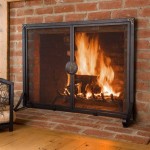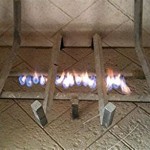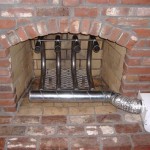Fireplace Surround Ideas With TV: Balancing Aesthetics and Function
Integrating a television into a living space that also features a fireplace presents a design challenge. Both elements tend to act as focal points, vying for attention and potentially disrupting the overall aesthetic. Successfully combining a fireplace surround with a TV requires careful consideration of spatial arrangement, design harmony, and functional practicality. This article explores various strategies and design ideas to achieve a balanced and visually appealing integration of both features.
Spatial Considerations and Layout Planning
The initial step in designing a fireplace surround with a TV is to assess the room's spatial constraints and determine the optimal layout. Factors such as room size, shape, seating arrangement, and viewing distance influence the placement of both the fireplace and the TV. Ideally, the viewing distance should be proportionate to the size of the TV screen to ensure comfortable viewing. A common rule of thumb is that the viewing distance in inches should be approximately 1.5 to 2.5 times the diagonal screen size. Similarly, the size of the fireplace surround should be proportional to the overall dimensions of the wall and the room to avoid overwhelming the space.
One common approach is to center both the fireplace and the TV on the same wall. This creates a unified focal point and simplifies the design process. However, this setup can be challenging if the fireplace is significantly offset from the center of the wall. In such cases, consider using architectural elements or built-in cabinetry to create a sense of symmetry and balance. Alternatively, the fireplace and TV can be placed on adjacent walls, which can be a suitable solution for corner fireplaces or rooms with limited wall space. Regardless of the chosen layout, it's crucial to maintain proper viewing angles and minimize glare from windows or other light sources.
Before making any permanent changes, it's advisable to experiment with different layouts using furniture placement and temporary visual aids. This allows for a better understanding of how the space will function and appear once the fireplace surround and TV are installed. Consider drawing a scaled floor plan or using a 3D modeling tool to visualize the proposed design.
Design Harmony and Aesthetic Integration
Achieving design harmony between the fireplace surround and the TV is essential for creating a visually appealing living space. The goal is to integrate both elements seamlessly into the overall décor, rather than treating them as separate entities. This can be achieved through careful selection of materials, colors, and styles that complement each other and the existing architectural features of the room.
One popular approach is to construct a custom built-in unit that houses both the fireplace and the TV. This allows for a cohesive design that integrates both elements into a single architectural feature. The built-in unit can be designed to accommodate storage shelves, display cabinets, or other functional elements, further enhancing its versatility. The materials used for the built-in unit should be carefully chosen to complement the style of the fireplace surround and the TV. Common materials include wood, stone, brick, and metal. The finish and color of the materials should also be considered to ensure a harmonious blend with the existing décor.
Another design strategy is to use a consistent architectural style for both the fireplace surround and the TV area. For example, if the fireplace surround features a traditional design with ornate moldings and a marble mantel, the TV area can be designed with similar architectural details to create a cohesive look. Conversely, if the fireplace surround features a modern design with clean lines and minimalist details, the TV area can be designed with a similar aesthetic. This approach ensures that both elements complement each other and contribute to the overall design harmony of the room.
Consider incorporating elements that visually connect the fireplace surround and the TV. This can be achieved through the use of shared materials, colors, or patterns. For example, if the fireplace surround features a stone veneer, a similar stone veneer can be used as an accent wall behind the TV. Alternatively, a common color palette can be used for the fireplace surround, the TV unit, and the surrounding décor. These subtle connections can help to create a sense of unity and visual cohesion within the space.
Functional Considerations and Technological Integration
Beyond aesthetics, it's crucial to consider the functional aspects of integrating a TV into a fireplace surround. This includes ensuring proper ventilation for the TV, managing cables and wires, and optimizing viewing angles for comfortable viewing. Failure to address these functional considerations can result in technical issues, aesthetic disruptions, and an overall compromised viewing experience.
Heat management is a primary concern when placing a TV above a fireplace. TVs are sensitive to heat, and excessive exposure can damage their internal components and shorten their lifespan. To mitigate this risk, it's essential to ensure adequate ventilation around the TV. This can be achieved by incorporating ventilation openings in the fireplace surround or by installing a heat shield above the fireplace. The heat shield deflects heat away from the TV, preventing it from overheating. It's also advisable to consult with a professional installer to ensure that the TV is installed at a safe distance from the fireplace and that adequate ventilation is provided.
Cable management is another important consideration. The unsightly mess of cables and wires associated with TVs and other electronic devices can detract from the overall aesthetics of the room. To address this issue, it's recommended to conceal cables and wires within the walls or within the built-in unit. This can be achieved by running the cables through conduit pipes or by using cable management systems. Wireless technology can also be used to minimize the number of visible cables. For example, wireless HDMI transmitters can be used to transmit video and audio signals from the TV to other devices without the need for physical cables.
Optimizing viewing angles is crucial for ensuring a comfortable viewing experience. The TV should be positioned at a height and angle that allows for comfortable viewing from the seating area. Ideally, the center of the TV screen should be at eye level when seated. However, this may not always be possible, especially if the TV is mounted above a fireplace. In such cases, consider using a tilting TV mount to adjust the viewing angle and minimize glare. A tilting mount allows you to angle the TV screen downwards, improving visibility and reducing eye strain. It's also important to consider the distance between the TV and the seating area when determining the optimal viewing angle.
Sound system integration is another factor to consider. The placement of speakers can significantly impact the sound quality of the viewing experience. If the TV is mounted within a built-in unit, consider incorporating in-wall or in-ceiling speakers for a clean and minimalist look. Alternatively, freestanding speakers can be used, but they should be carefully positioned to avoid obstructing the TV screen or creating a cluttered appearance. Wireless speakers can also be used to minimize the number of visible wires.
Finally, consider the integration of smart home technology. Smart TVs can be integrated with smart home systems to control lighting, temperature, and other aspects of the home environment. Voice control assistants can also be used to control the TV and other devices hands-free. These technological integrations can enhance the convenience and functionality of the living space.
Materials and Finishes: Reflecting Style and Durability
The choice of materials and finishes profoundly impacts the overall aesthetic and longevity of the fireplace surround and TV integration. Selecting materials that align with the desired style, offer durability, and complement existing décor is crucial for a successful design.
Wood offers warmth and versatility, making it a popular choice. Different wood species, stains, and finishes provide a range of stylistic options, from rustic to modern. Solid wood can be used for framing and structural elements, while veneers can be applied to surfaces for visual appeal and cost-effectiveness. It's essential to select wood treated for fire resistance, particularly in close proximity to the fireplace opening.
Stone, including natural stone and manufactured stone veneer, adds a touch of elegance and timelessness. Natural stone options like marble, granite, and limestone offer unique textures and patterns, while manufactured stone veneer provides a more affordable and lightweight alternative. Stone is inherently fire-resistant, making it a safe and practical choice for fireplace surrounds. The color and texture of the stone should be carefully chosen to complement the existing décor and the overall style of the room.
Brick offers a rustic and charming aesthetic, making it ideal for traditional or farmhouse-style homes. Brick is also a durable and fire-resistant material, making it suitable for fireplace surrounds. Brick can be painted or stained to achieve a variety of colors and finishes. The texture and pattern of the brick can also be varied to create different visual effects.
Metal, such as stainless steel, wrought iron, or brushed aluminum, can be used to add a modern and industrial touch. Metal is a durable and fire-resistant material, making it suitable for both the fireplace surround and the TV unit. Metal can be used as an accent material or as the primary material for the entire structure. The finish of the metal should be carefully chosen to complement the other materials and the overall style of the room.
Paint and other finishes play a crucial role in the overall aesthetic. Paint can be used to add color, texture, and visual interest to the fireplace surround and the TV unit. The color of the paint should be chosen to complement the existing décor and the overall style of the room. Different paint finishes, such as matte, satin, or gloss, can be used to create different visual effects. Other finishes, such as wood stains, varnishes, and sealants, can be used to protect and enhance the beauty of the materials.
Ultimately, the successful integration of a fireplace surround and a TV requires thoughtful planning, careful material selection, and attention to both aesthetic and functional considerations. By carefully considering these factors, it is possible to create a living space that is both visually appealing and comfortable.

20 Amazing Tv Above Fireplace Design Ideas Stone Designs Home

Placing A Tv Over Your Fireplace Design Ideas Classic Living Room Home White

Tv Above Fireplace Design Ideas

Mantel Decorating With A Tv 10 Ideas And Tips Nina Hendrick

Best Modern Fireplace Designs Blaze

A Tv Over The Fireplace Design Yes Or Major No

Pin On Family Rooms I Like

Contemporary Modern Fireplace Designs With Tv Above Mantel

10 Best Ideas For Decorating A Mantel With Tv Above It

Real Life Rooms Decorating Ideas For A Tv Above Fireplace Remodelaholic
Related Posts








